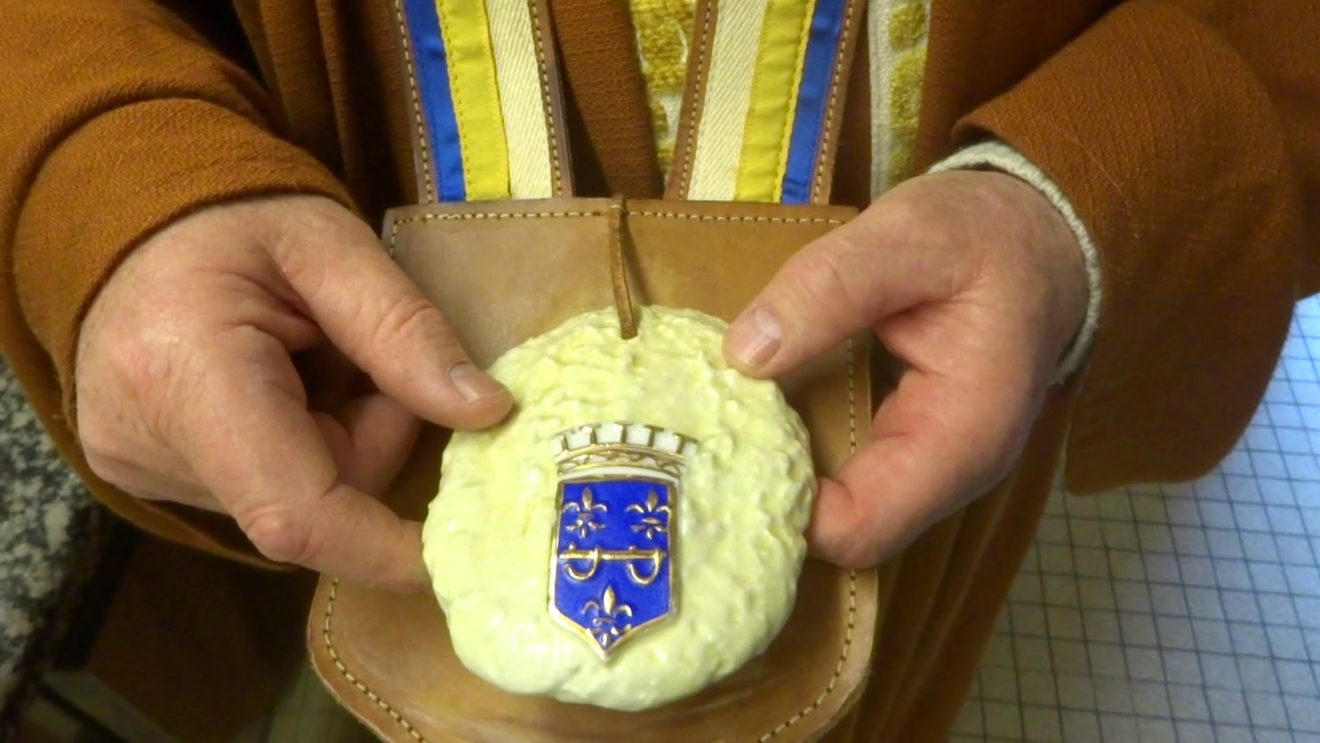
When describing the location of a town in the center of France, I often struggle to find a point of reference for those less familiar with the country’s geography. “Just say that it’s near Limoges,” a tourist official suggested regarding Saint Leonard de Noblat, the subject of this two-part article. “Everyone’s heard of Limoges.” True, but they’ve heard of Limoges as fine bone china and hard-paste porcelain, not as the actual zone where it’s produced.
The most appropriate reference point for situating Saint Leonard de Noblat isn’t a point but a line, that of the major medieval pilgrimage route from Vezelay, in Burgundy, to the relics of Saint James in Compostela, Spain. Follow it on foot, as a pilgrim did/does, proceeding at a steady pace of 14 miles (23 km) per day, and you’ll arrive in Saint Leonard de Noblat after a month or so, with another eight weeks to go before Compostela. With that as your line of reference, here’s the map to situate you.
That line, that pilgrimage along the Way of Saint James (Camino de Santiago), and more specifically the relics of Saint Leonard along the Way, is what earned Saint Leonard de Noblat a significant dot on the map.
My own approach was by car from Aubusson, of tapestry fame, 41 miles (66km) to the east. Courtney Withrow approached from Limoges, 13 miles (21km) to the west. We meet here in this 2-part article, where, in this part, I give an overview of town and its development and where, in the second part, Courtney tells of its 500-year-old paper mill Le Moulin du Got.
Doubly present on the UNESCO World Heritage List
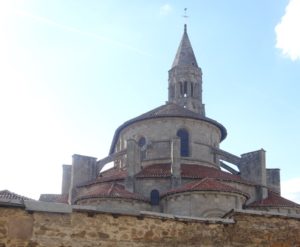
So let’s forget for a moment that Saint Leonard de Noblat is well off the beaten path for most travelers. Instead, we’ll return to a time and a place where it was very much on the path of pilgrims. Thanks to that path, this town of 4500, whose historic center is preserved in its stone simplicity, is doubly present on the UNESCO World Heritage List:
– Tangibly, for its collegiate church that was a part of a dense constellation of medieval structures in France along the Way of Saint James;
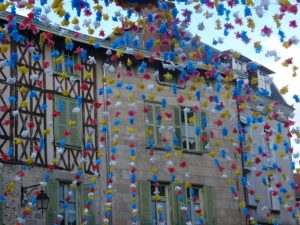
– Intangibly, as part of religious processions and ceremonies known as Limousin Septennial Ostensions, organized every seven years to present and worship the relics of saints held in the region. (An ostension is a presentation of relics.) About 20 towns in the region—most within 25 miles of Limoges, along with several outliers—band together during the Ostensions to “translate” or move their local relics from town to town through the septennial year. The next Ostensions will take place in 2023.
Leonard, patron saint of prisoners
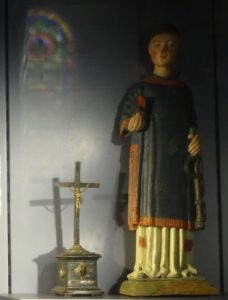
Nobiliacum (which morphed into Noblac and Noblat) was the name of the village overlooking the Vienne River that existed here in the Dark Ages before becoming fully associated with Saint Leonard through the veneration of his relics during the Middle Ages. Saint Leonard’s life story was written in 1030, nearly 500 years after his death, so it’s as much legend as biography. As word of it spread so did the appeal of visiting his relics and perhaps benefiting from their healing powers.
As the story goes, Leonard was born into aristocracy in the late 5th century during the time of Clovis, King of the Franks. Like Clovis, he was baptized by Saint Remi in Reims, with Clovis himself as his godfather. Become a pious adult, Leonard was given by Clovis the right to release prisoners that Leonard felt worthy of amnesty, hence his status as the patron saint of prisoners. Effigies of the saint present him holding shackles and/or chains, perhaps also with a fleur de lys to symbolize his royal connection. Leonard eventually chose to live as a hermit in the forest by the crossroads that would become Nobiliacum and that would eventually also bear his own name. Hermits took part in evangelizing a region by setting up shop in the forest near well-traveled roads. Miracles followed.

At the turn of the millennium, word was spreading throughout the region and beyond of the miraculous healing powers of a procession of the relics of Saint Martial of Limoges during an epidemic of ergot poisoning, an epidemic caused by grain infected with certain fungi that would strike the Limousin region. As the biography of Saint Leonard gained ground during the second half of the 11th century, other miracles of relief or cure would then be attributed to a procession of his relics, giving further credence to the power of ostensions. Funding from passing pilgrims and from feudal powers contributed to the creation of many churches through the 11th and 12th centuries along the pilgrimage routes of central and southwest France. The mostly Romanesque collegiate church of Saint Leonard de Noblat was a part of that movement. Today, still, it houses the saint’s relics, particularly his skull.
Massepain, the local pastry
Pilgrimages are intended to provide spiritual strength, but long-distance pilgrims, in addition to having sore feet, often had difficulties being suitably nourished. Two 13th-century entrances to a former pilgrim’s hospital still visible in town attest to the physical suffering of pilgrims.
My own visit to Saint Leonard de Noblat knew no suffering. In fact, while I spent some time visiting the old stones and the old bones of Saint Leonard de Noblat, my first encounter with the history of the pilgrimage to and through town came in the form of a pastry called massepain.
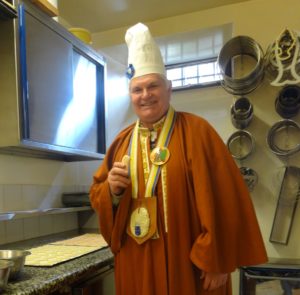
Actually, my first encounter wasn’t with a massepain but with Frédéric Rougerie, a founding member and master of ceremonies of the Confrérie des Compagnons de Massepain de Saint Leonard de Noblat, the order or brotherhood that protects and promotes traditional Saint Leonard massepain. Meeting me in the kitchen at Maison Coignac (22 Avenue du Maréchal Foch), a family-run pastry shop and bakery, one of many shops in town making massepain, he greeted me in full brotherhood regalia: a brown cape, the color of the full almonds that go into the pastry (and of Limousin cows); a neck baldric meeting at a patch of Limousin leather on which is attached, in locally-made Limoges porcelain, a reproduction of a massepain bearing the image of the arms of Saint Leonard; a large broach indicating an affiliation with other Limousin brotherhoods, and a pastry chef’s hat.
Calling massepain a pastry makes it sound fancier than it truly is. It’s simply a soft, dry, rustic biscuit made of three ingredients: almonds, egg whites and sugar. I resist translating massepain as marzipan since that risks calling to mind dense almond paste that’s often molded into animal-shaped confections. Marzipan it may be, but this one is so particular to Saint Leonard that it’s best to call it by its French name. Saint Leonard de Noblat is also known as the City of Massepain.
For pilgrims traveling on a poor diet of water, cabbage leaves and some root vegetables, almond-based biscuits were, says Rougerie, the equivalent of a high-protein sports bars. Almonds grow along the Mediterranean basin, so almonds and almond-based confections were known to southern travelers. However, the traditional recipe of the massepain of Saint Leonard practiced today wasn’t developed until 1899, when the local pastry maker Camille Petitjean learned a similar recipe from a Swiss monk who was passing through on the pilgrimage route. Petitjean sold them in town and in surrounding villages, and massepains soon became a staple of the sweet and rustic life in and around Saint Leonard.
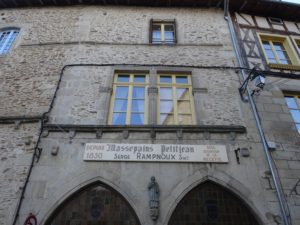
Three ingredients go into the traditional Saint Leonard massepain: almonds (the full almond which is then finely crushed), egg whites (unbeaten) and sugar (caster). Despite its Mediterranean roots, the United States is currently the world’s largest almond producer, so many a Saint Leonard massepain likely contain California almonds. By its ingredients, the massepain is cousin to the Parisian macaroon, but it’s very much a country cousin. The macaroon doesn’t use the full almond fruit, its egg white is beaten, and its sugar is powdered, making it suitable for a highfalutin pilgrimage to Paris but not to Saint Leonard de Noblat.
Pilgrims make up only a tiny part of the clientele for massepain. The bulk is consumed by, well, everyone living in or passing through the region. Massepains can be enjoyed at aperitif-time with, say, a glass of pink champagne if you want to go upmarket with your downmarket pastry, in the afternoon with coffee or tea, even by a teething toddler. You name it, the simple yet versatile massapain can have its place.
Come mealtime, however, the traveler to the region inevitably opts for a hearty sit-down meal that may be inspired by the farmland of Saint Leonard de Noblat and the surrounding Limousin region, where you’ll see Limousin cattle, as well as Limousin lamb and Black Bottom pigs. Chestnuts and Limousin apples are also grown in the region.
Porcelain, Paper and Leather
While Saint Leonard now putters along as a largely off-track town in 21st century France, it maintains its attachment not only to its pilgrimage prosperity during the Middle Ages but also to its substantial period of prosperity as a hub for artisanal activity during the 17th and 18th centuries.
To understand the artisanal prosperity, your reference map would show the rivers running through the region, in particularly the Vienne River, which lent its name to the department or sub-region called Haute-Vienne or Upper Vienne. (Saint Leonard and Limoges are far upstream along the Vienne. Further downstream, the river makes a sharp turn north and eventually flows into the Loire River near Saumur.) The quality of its water and that of its small tributaries at this stage of its course encouraged the development two types of water-dependent manufacturing complexes: tanneries, treating hides for leather goods, and papermills. The Vienne also played a role in the development of the porcelain industry in and around Limoges.
Tanneries: By the 19th century there were about 20 sites for tanning hides in the area. The only one now in operation is Tannerie Bastin & Fils. Bastin is a 200-year-old tanner that opened the functioning Moulin Follet (Follet Mill) site in 1892 and has been owned by J.M. Weston since 1981. Weston, based in Limoges, uses leather made here for shoe soles.
Papermills: There were also some 20 paper producers in the heyday of artisanal paper production in the Saint Leonard area in the 18th century. Again, only one remains, the Moulin du Got, which Courtney Withrow tells about in the second part of this article.
Porcelain: Fine bone china and hard-paste porcelain considered “Limoges” isn’t only made in the city of Limoges or by a single producer but by artisans and industry throughout the region who have access to the proper clay within the production zone.
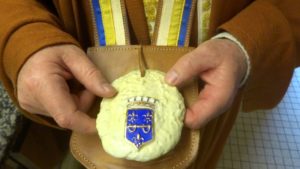
The region was actually known for centuries for its enamel production prior to gaining an international reputation for its porcelain in the early 18th century. In Saint Leonard, the local star of fine porcelain production is Coquet, producer of the brands J.L Coquet and Jaune de Chrome. (Two years ago the company was caught up in revelations of The Daphne Project with respect to money laundering. Since 2019, Coquet has belonged to the Compagnie Européenne de Luxe et Traditions.) Porcelaine Carpenet, a family-run Limoges producer, is also located in Saint Leonard.
Saint Leonard de Noblat Tourist Office, Place du Champ de Mars, 87400 Saint-Léonard de Noblat. The tourst office website provides a list of hotels and B&Bs in the area. Note: This is not an area for luxury accommodations or haute cuisine.
Haute-Vienne Tourist Information. Saint Leonard and Limoges are within the department of Haute-Vienne. Americans on the Statue of Liberty tour of France (there are about 25 replicas in France, in addition to those in Paris) might head 12 miles southeast to Châteauneuf-la-Forêt, where one stands as the monument to the dead of the First and Second World Wars. Not much else to see once you get there, but a drive though Haute-Vienne countryside nonetheless.
Oradour sur Glane, the “martyred village,” is also located in Haute-Vienne, 28 miles (46km) west of Saint Leonard de Noblat.
© 2020, Gary Lee Kraut
Go to the second part of this 2-part article Saint Leonard de Noblat: 500 Years of Paper Production.


Hi Gary – My brother-in-law’s name is Leonard. He is the chaplain of the Buffalo Bills AND his other ministry is to prisoners. Who knew he was following this saint who shares his name. We and he were happy to discover your article and even though you said this would not be on most tourist paths, but it just so happens that we are headed to Auverge and will happily stop in St Leonard on the way! Thanks for the article and inspiration. Lisa
Hi Lisa,
I’m glad to hear that off-the-beaten-path is your path. Please let me know your thought on your stop in St. Leonard afterwards.
Happy travels always,
Gary